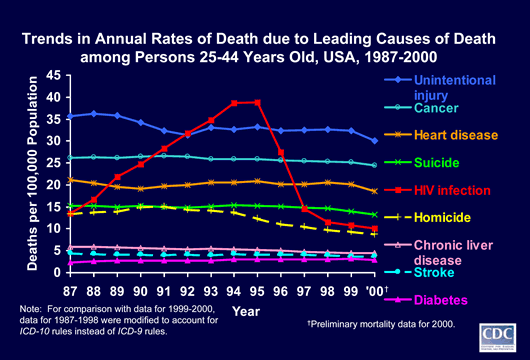
"If you think research is expensive, try disease."
- Mary Woodard Lasker
In addition to saving lives and improving America's health, biomedical research conserves costs and leads to economic growth. A healthier nation means a larger workforce with greater productivity. While a child born in 1900 had an average life expectancy of 47 years, today's average life expectancy has soared to 77 years1. Those extra years translate into dollars: The Congressional Joint Economic Committee has estimated a net annual gain of $2.4 trillion as a result of increased life expectancy alone2.
AIDS Drugs: Research Rescues Life
One of the ways research is extending life is through the discovery of new medicines to fight terrible diseases like AIDS. In 1981, doctors witnessed the beginning of the AIDS disaster, when the first cases of infection with the human immunodeficiency virus, or HIV, began to emerge. Despite the fact that at the time researchers quickly realized the devastation that AIDS would likely cause, HIV deaths continued to climb at an alarming rate throughout the 1980s and early 1990s. Every year during that period, AIDS killed approximately a half million Americans between the ages of 25 and 44.
But in 1995, AIDS deaths dropped sharply, as a result of the discovery of an entirely new way to treat HIV infection (Fig. 1). The American public soon came to know the new life-saving therapy as "the cocktail." It meant using a combination of medicines to attack HIV in different ways and leaving the virus with few means to escape. The critical component of this mixture of medicines was a new and different kind of drug called a protease inhibitor. Basic research supported by the National Institute of General Medical Sciences led directly to the discovery of this life-saving class of medicines.

Fig. 1. AIDS deaths dropped sharply in 1995, when HIV protease inhibitors became available to patients
CDCStructural Biology Points the Way to Important Medicines
Protease inhibitors prevent HIV from making more of itself. The discovery of protease inhibitors was the fruit of a systematic, scientific grass-roots effort to outwit the killer HIV. The effort would not have been possible without a research approach called structural biology, in which scientists determine the three-dimensional shapes of proteins using high-energy X rays. In structure-based drug design, scientists marry computer modeling with protein structure data. The idea is to map every crevice of a protein target of a disease in order to design ways to stop the protein from working. An important component of the technique is finding and/or tailor-making small molecules to "fit" the protein's shape.
In the early 1980s, this approach was just taking hold, but it did not enjoy widespread respect from the scientific community or funding agencies. NIGMS boldly encouraged scientists to blaze a trail in this scientific area, and the results of this research investment paid off enormously. In particular, an NIGMS grant to what was then Agouron Pharmaceuticals, Inc., yielded the protease inhibitor drug Viracept®.
Suddenly, people could live with AIDS for decades. Estimates now predict a $7.5 billion dollar economic value gain resulting from the reduction in AIDS deaths that occurred over the past two decades3. Even assuming only a part of this reduction can be attributed to the effectiveness of cocktail therapy, the savings from this investment are impressive.
The AIDS story is dramatic, but structure-based drug design has produced several other life-saving drugs that are a vital part of every day for people with a wide range of health problems including arthritis, glaucoma, and the flu (Table 1). The prevalence and health costs of treating these disorders is significant. For example, according to the Arthritis Foundation, 40 million people have arthritis, which costs the United States $65 billion annually.
New Paths of Drug Discovery
Scores of drugs developed from structure-based drug design are in the industry pipeline. A new treatment for liver cancer, Thymitaq®, is in the final stage of clinical testing and has earned a "fast track" rating from the Food and Drug Administration. Such an action will grant this drug a priority review from the U.S. drug approval agency.
Structure-based drug design is an integral part of drug discovery today. While it can't be said that the approach is necessary and sufficient to getting a drug to market, no single technology can claim that ability. Part of the reason is that structure-based drug design is actually a collection of technologies that includes molecular biology, computational chemistry, and bioinformatics. Above all, the approach hinges on people working together in interdisciplinary teams to attack a disease target through custom-design of a new drug.
Structure-based drug design speeds drug discovery by helping industry chemists to narrow down molecule choices, to find a needle in a towering haystack. Obtaining structures of a drug target complexed with a series of candidate drugs can guide downstream drug development decisions related to bioavailability, toxicity, and manufacturing.
It is clear that targeted strategies to find new medicines is a successful approach that is saving lives every day. As more drugs derived from structure-based drug design come to market, many more success stories will be waiting to be told.
Sources
1Arias E, Smith BL. Deaths: Preliminary data for 2001. National Vital Statistic Reports 51(5) http://www.cdc.gov/nchs/data/nvsr/nvsr51/nvsr51_05.pdf [requires free Adobe Acrobat Reader to view]
2National Institutes of Health. A plan to ensure taxpayer interests are protected, NIH response to the conference report request for a plan to ensure taxpayer's interests are protected. July 2001 http://www.nih.gov/news/070101wyden.htm
3Murphy, KM, Topel RH. Measuring the gains from medical research: An economic approach. 2003. University of Chicago Press.
Content created August 2007
